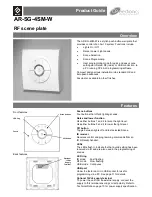
Application Note
4
<Revision 2.4>
<<2019-06-17>>
Assembly Instructions for the Easy-PressFIT Modules
2
Requirements for printed circuit boards
The PressFIT technology used in the Easy modules has been inspected and qualified by Infineon Technologies
AG for standard FR4 PCBs with tin applied chemically (IEC 60352-5 + IEC60747-15). If other handling
technologies are to be used in the production of PCBs, they have to be tested, inspected and qualified.
Requirements for the PCB material:
Double-sided PCB according to IEC 60249-2-4 or IEC 60249-2-5.
Multilayer PCB according to IEC 60249-2-11 or IEC 60249-2-12.
Table 1
Requirements for a PCB
Minimum
Typical
Maximum
Hole drill diameter
1.12 mm
1.15 mm
Copper thickness in hole
> 25
µ
m
< 50
µ
m
Metallization in hole
< 15
µ
m
End hole diameter
0.99 mm
1.09 mm
Copper thickness of
conductors
35
µ
m
70
µ
m
105
µ
m
400
µ
m
Metallization of circuit
board
Tin (chemical) recommended
Metallization of pin
Tin (galvanic)
In order to ensure that the PressFIT contact sits securely in the PCB, the specification of the hole given in Table
1 must be adhered to.
If the specification of PressFIT holes is limited to only the finished dimension (i.e., the metallized hole), different
drill sizes could be used depending on the PCB manufacturer and production philosophy, and also different
metallization thicknesses could be provided. This would lead to results that would have to be rejected for
quality assurance reasons. The end hole diameter is a function of the drill hole, the copper thickness and
the metallization in the hole.
The recommendation still applies that the hole in the PCB is to be drilled during manufacture with a drill size of
1.15 mm, and should not be milled. Experience has shown that a final hole diameter between 1.12 mm and 1.15
mm is obtained under consideration of the runout tolerances of the spindles after drilling due to shrinking of
the FR4 material.
With a copper thickness of 30
µ
m to 50
µ
m in the hole and a tin layer of about 1
µ
m for tin applied chemically,
an end hole diameter is obtained as the test dimension. Due to the thinner tin layer thickness, this diameter is
always higher than the value of 1 mm stated in the standard (IEC 60352-5). The final hole diameter, considering
the drilling diameter, copper thickness and a chemical tin layer, is typically between 1.02 mm and 1.09 mm.




































